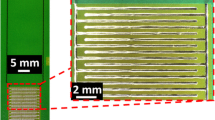Abstract
This paper presents the results of humidity testing of weak organic acids (WOAs), namely adipic, succinic, glutaric, dl-malic, and palmitic acids, which are commonly used as activators in no-clean solder fluxes. The study was performed under humidity conditions varying from 60% relative humidity (RH) to ∼99%RH at 25°C. The following parameters were used for characterization of WOAs: mass gain due to water adsorption and deliquescence of the WOA (by quartz crystal microbalance), resistivity of the water layer formed on the printed circuit board (by impedance spectroscopy), and leakage current measured using the surface insulation resistance pattern in the potential range from 0 V to 10 V. The combined results indicate the importance of the WOA chemical structure for the water adsorption and therefore conductive water layer formation on the printed circuit board assembly (PCBA). A substantial increase of leakage currents and probability of electrochemical migration was observed at humidity levels above the RH corresponding to the deliquescence point of WOAs present as contaminants on the printed circuit boards. The results suggest that use of solder fluxes with WOAs having higher deliquescence point could improve the reliability of electronics operating under circumstances in which exposure to high humidity is likely to occur.
Similar content being viewed by others
References
Montreal Protocol on Substances that Deplete the Ozone Layer. United Nations Environment Programme (1987).
W.M. Haynes and D.R. Lide, CRC Handbook of Chemistry and Physics, 94th ed. (Boca Raton: CRC Press, 2013), p. 2668.
J.E. Sohn and U. Ray, Circuit World 21, 22 (1994).
M.S. Jellesen, D. Minzari, U. Rathinavelu, P. Møller, and R. Ambat, Eng. Fail. Anal. 17, 1263 (2010).
D. Geiger and D. Shangguan, Solder. Surf. Mt. Technol. 17, 27 (2005).
L.J. Turbini, G.B. Freeman, M.H. Smith, J.D. Finney, R.D. Boswell, and J.F. Lane, Solder. Surf. Mt. Technol. 3, 24 (1991).
C. Puechagut, A. Laügt, E. Guéné, and R. Anisko, Solder Paste Residue Corrosivity Assessment: Bono Test, in IPC APEX EXPO Technical Conference (2010), vol. 2, p. 1336.
Y. Zhou, L.J. Turbini, D. Ramjattan, B. Christian, and M. Pritzker, J. Electron. Mater. 42, 3609 (2013).
J.R. White, IBM J. Res. Dev. 37, 243 (1993).
J.C. Galvan, J.M. Bastidas, and S. Feliu, Weld. J. 75, 366 (1996).
J. Guy and M. Fredrickson, NEPCON WEST 3, 1270 (1997).
N.M. Amin and A.M. Seitz, NEPCON WEST 2, 845 (1999).
L.C. Zou and C. Hunt, J. Electrochem. Soc. 156, C8 (2009).
C. Hunt and L. Zou, Solder. Surf. Mt. Technol. 11, 36 (1999).
S. Zhan, M.H. Azarian, and M. Pecht, IEEE Trans. Device Mater. Reliab. 8, 426 (2008).
K.G. Schmitt-Thomas and C. Schmidt, Solder. Surf. Mt. Technol. 3, 4 (1994).
Peter. Biocca, Flux chemistries and thermal profiling considerations in SMT assembly. National Electronic Packaging and Production Conference-Proceedings of the Technical Program (West and East) 2, 971 (1999).
K.S. Hansen, M.S. Jellesen, P. Moller, P.J.S. Westermann, and R. Ambat, Effect of Solder Flux Residues on Corrosion of Electronics, in Annual reliability and maintainability symposium (2009), p. 503.
B.A. Smith and L.J. Turbini, J. Electron. Mater. 28, 1299 (1999).
V. Verdingovas, M.S. Jellesen, and R. Ambat, IEEE Trans. Device Mater. Reliab. 14, 42 (2014).
IPC-9201, Surface Insulation Resistance Handbook (Northbrook: IPC, 1996).
G. Sauerbrey, Z. Phys. 155, 206 (1959).
K.M. Adams, J.E. Anderson, and Y.B. Graves, Circuit World 20, 41 (1994).
C. Peng, M.N. Chan, and C.K. Chan, Environ. Sci. Technol. 35, 4495 (2001).
P. Saxena and L.M. Hildemann, Environ. Sci. Technol. 31, 3318 (1997).
C. Cruz and S. Pandis, Environ. Sci. Technol. 34, 4313 (2000).
A. Apelblat, M. Dov, J. Wisniak, and J. Zabicky, J. Chem. Thermodyn. 27, 35 (1995).
M.E. Orazem and B. Tribollet, Electrochemical Impedance Spectroscopy (Hoboken: Wiley, 2008), p. 524.
E. Barsukov and J. Ross Macdonald, Impedance Spectroscopy Theory, Experiment, and Applications (Hoboken: Wiley, 2005), p. 595.
O. Thomas, M. Wickham, and C. Hunt, Circuit World 38, 68 (2012).
H. Conseil, M.S. Jellesen and R. Ambat, Solder. Surf. Mt. Technol. 26, 194 (2014).
Author information
Authors and Affiliations
Corresponding author
Rights and permissions
About this article
Cite this article
Verdingovas, V., Jellesen, M.S. & Ambat, R. Solder Flux Residues and Humidity-Related Failures in Electronics: Relative Effects of Weak Organic Acids Used in No-Clean Flux Systems. J. Electron. Mater. 44, 1116–1127 (2015). https://doi.org/10.1007/s11664-014-3609-0
Received:
Accepted:
Published:
Issue Date:
DOI: https://doi.org/10.1007/s11664-014-3609-0




